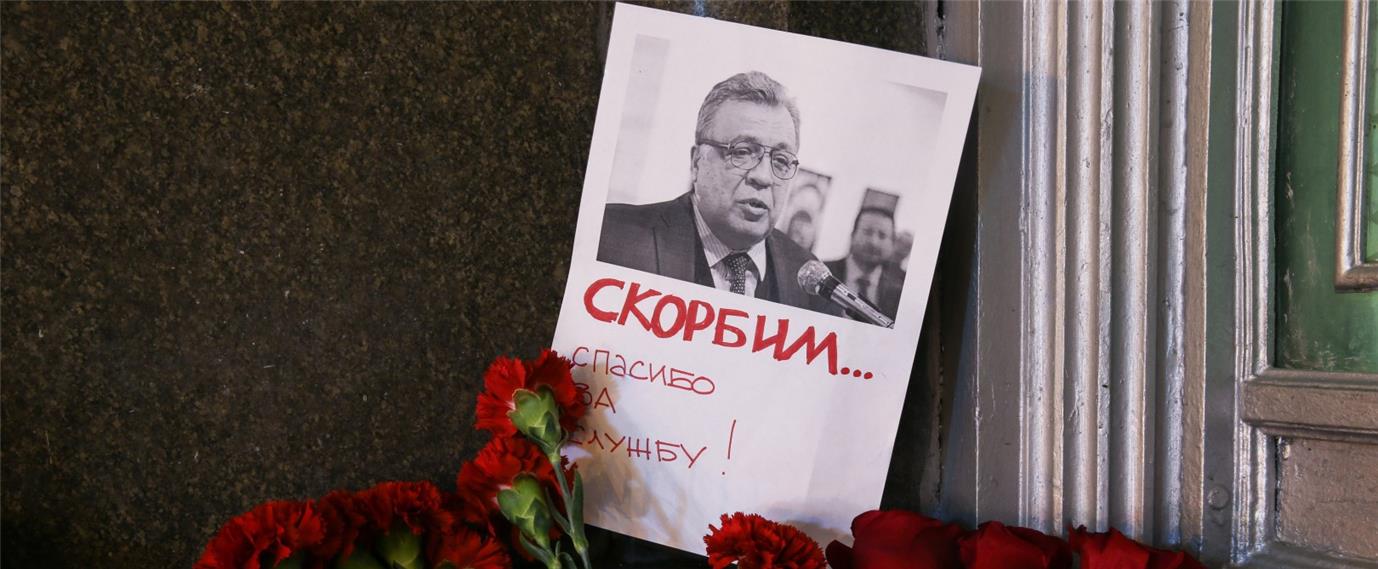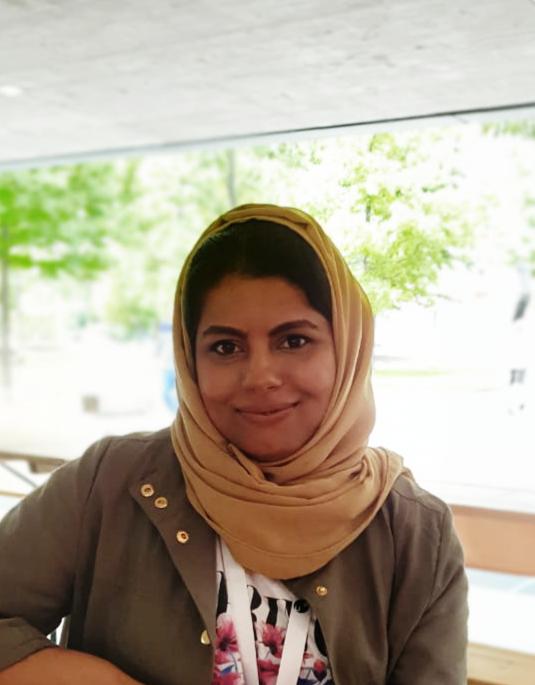حصدت الصورة الصحفية لمقتل أندريه كارلوف، السفير الروسي في تركيا، على يد حارسه الشخصي على جائزة منظمة الصورة الصحفية الدولية كأفضل صورة للعام المنصرم 2016، وذلك في حفل بمدينة أمستردام، حيث تنافست حوالي 80 ألف صورة صحفية تم تقديمها للمسابقة من 125 دولة حول العالم. ورغم أن حادثة مقتل السفير الروسي كانت موثقة عبر كاميرا تصوير فيديو أيضا؛ إلا أن الصورة الفوتوغرافية انتشرت انتشارا هائلا عبر وسائل التواصل الاجتماعي، وتناقلتها محطات البث التلفزيونية وكبرى الصحف العالمية، وهي تظهر القاتل الغاضب يرتدي ملابس رسمية سوداء، ومن خلفه تظهر جثة السفير الروسي ملقاة على الأرض، بينما يشير القاتل بإصبعه إلى السماء وتصطف في الخلف البعيد لوحات من المتحف الفني الذي شهد وقوع الحادثة.
لم يكن الحدث الذي جسدته كاميرا الصحفي برهان أزبيليك مجرد رصد لفعل سياسي وإجرامي فحسب؛ بل ترك عددا من المعطيات والمعاني الصحفية والفنية، وأفضى إلى تساؤلات حول المآخذ الأخلاقية التي يمكن أن يحمل عبئها مثل هذا العمل، وهو ما تحاول هذه المقالة تقديمه عبر تفسير متعدد لدلالات الصورة.
يمكن القول إن فوز هذه الصورة لم يكن مخيبا للآمال بالمرة، كما لم يكن انتشارها محض صدفة، ليس فقط لأنها تعبر عن حدث سياسي تجسده شخصية هامة كالسفير الروسي فحسب، بل لأن كافة الظروف والمعطيات تجمعت سويا لتبرز عملا مرئيا مدهشا وملفتا للجميع، لذلك الحد الذي يدفعنا للتساؤل: كيف تسرب هذا المشهد بالغ السوريالية بهذه السهولة لملايين من البشر حول العالم؟
صورة بوسعها أن تتحدث
إذا كان جليا للجميع أن الصورة بإمكانها أن تقول ألف كلمة؛ فإن صورة مقتل السفير الروسي في تركيا قد تحدثت حتما، وخاطبتنا كما لو أنها رجل يتقن كل اللغات. وامتدت الصورة في بروزها للمتلقي لتجسد الحدث كما لو كان مشهدا سينمائيا مكتمل الأركان عبر نقل متكامل للمشهد، حيث تظهر الصورة كافة الفاعلين (القاتل والضحية والمكان ثم الحدث الذي سبب شيوع الفوضى) كعناصر أساسية على مساحة واحدة من القرب، لدرجة أن باستطاعة عدسة الكاميرا أن تضع كل هذه العناصر سويا في صورة واحدة.
وحينما نعبر عن أبجديات هذا التكامل في الصورة، فنحن نستذكر الصور الصحفية الكثيرة التي نصادفها كل يوم عبر وسائل الإعلام، صور القتلى في التفجيرات الإرهابية في سوريا والعراق مثلا، وهم يتمددون على طول الشوارع والأزقة، بينما يغيب القاتل أو يكاد يتلاشى كالفتات في حطام المكان. لكن صورة مقتل السفير الروسي تبدو مختلفة بعض الشيء، حيث أن القاتل والضحية يظهران بوضوح في عمل قلما يتكرر عبر وسائل الإعلام. وفي ذلك أستذكر تعليقا لأحد الأصدقاء حينما قمت بإرسال الصورة له بعد دقائق قليلة من نشرها عبر الشبكات الاجتماعية، حيث قال: لن يطيق العالم بعد اليوم فكرة أن يختفي القتلة، ينبغي أن يظهروا جميعا رفقة ضحاياهم بنفس المستوى وعلى مساحة واحدة.
تبرز الحادثة أيضا شجاعة للمصور وسرعة في تدارك الموقف أيضا، حيث يروي المصور تلك التجربة لوسائل الإعلام، ويشير إلى أن القاتل كان يعمد إلى تصويب مسدسه أمام الجميع، رغبة في إخافتهم ونيل استحواذه التام على الحدث، ما دفع ببعض الصحفيين والزائرين للمعرض إلى الهروب أو الانزواء في انتظار أن تفرج الأمور. وهنا يشير المصور قائلا: "قررت على الفور أن أقوم بعملي، ربما أصاب أو أموت، ولكن علي حتما أن أمثل الصحافة الجيدة".
لقد كان هذا المصور ملكا للحظة ومقتنصا لها كما لو كانت فريسة هائجة بوسعها أن تنقض عليه في أي لحظة. إن ذلك يدفعنا لمنح هذا الصحفي المزيد من الاهتمام والامتنان للشغف الذي أبداه تجاه المهنة، ما جعله في موقف المساومة مع موت قد يتحقق في أي لحظة.
قتل دون دماء
لقد أثارت هذه الصورة أيضا عنصرا سورياليا وبالغ القسوة، يظهر ما آلت إليه أحداث العالم المضطرب. فعلى الرغم من صعوبة الحديث عن علاقة الأعمال الصحفية التي تجسد أحداث الحياة المتسارعة بتلك التي تتطلب جهدا ودقة واشتغالا فنيا، إلا أن حضور هذا التقارب قلما يحدث في الصحافة العالمية، وإذا ما حدث فإنه يعد علامة فارقة في المنتج والتأثير المباشر الذي يحول الأحداث من صيغتها التدفقية السائدة عبر وسائل الإعلام إلى شكلها الإنساني المتقارب مع الذاكرة والمرتبط بالسلوك الإبداعي.
وفي صورة مقتل السفير الروسي فإن ثمة تقاربا بين الفن والنشاط الإبداعي من جهة ونقل المشهد الإعلامي من جهة أخرى، نجده أولا في تجسيد الصورة لحدث قتل متعمد وواضح المعالم والتفاصيل، ولكن دون ظهور بقعة دم واحدة، ما يترك دلالات على شيوع القتل لدرجة أنه بوسعنا أن نشهد الموت دون أن نرى بقع الدم ومناظر الجرحى والقتلى. ومن جهة أخرى، كان يبدو مكان الصورة فنيا وجميلا ومزينا باللوحات والأعمال الفنية التي تبعث على البهجة والفرح والأبيض المتدرج الذي يوحي بالسلام والطمأنينة، ويظهر البشر في الصورة وهم بأفضل حلة، حتى أن القاتل قرر أن يرتدي ملابس سوداء مرتبة، ما يعني تلاشي أي شكوك أو دواع للقلق والاضطراب. ودفع هذا التصور ببعض المحللين للتشكيك في مصداقية هذه الصورة أصلا والطعن في صحة تفاصيلها، ذلك لأن العقل الإنساني اعتاد أن يبصر الدمار المتراكم وامتداده في الأماكن المدمرة، بحيث تظهر عدسات الكاميرا شيوع هذا الدمار وتراتيبه المؤلمة يوما بعد يوم. وتنتشر صور القتلى وأشلاؤهم الممزقة، والجرحى وهم يقاسون الألم أمام شاشات التلفزة. يستدعي ذلك تذكر تلك الصور المؤلمة للقتل الجماعي للمئات من سكان حلب السورية، وتراتبية الصور التي تصلنا كل يوم، وهي تجسد الموت والدمار والفجيعة وأشكال القتلى وبقع الدم التي تنتشر في كل مكان، الأمر الذي سيتم استبعاده حتما في حدث دبلوماسي بالغ التنظيم كالحدث الذي شهد مقتل السفير الروسي.
دعاية لا يستحقها القاتل
الحديث المستمر عن عناصر قوة الصورة الصحفية التي نقلت قتل السفير الروسي لا يمكن أن يغفل المأخذ الأخلاقي في نقل هذه الصورة والتعبير عنها في وسائل الإعلام. لقد تسربت الصورة عبر وسائل الإعلام بدلالات بطولية تفرغ الحدث من فكرة القتل والغدر، لتعبر عن شجاعة وبطولة يبديها القاتل المسلح في مواجهة الموت.
وفي تقرير نشرته صحيفة واشنطن بوست، أشار بعض المحللين إلى أن حدة الصورة ودقتها وأهميتها في عالم صناعة الأخبار، لا يمكن أن ينسينا فكرة أن هذه الصورة منحت دعاية للقاتل وتجسيدا بطوليا لا يستحقه، عبر تمثيله كمكون هام من مكونات الصورة بل فاعل حقيقي في كينونتها، مشيرة إلى أن القاتل بدا للحظات أكثر أهمية وبروزا من الضحية الذي فارق الحياة. خطورة الأمر تكمن في أنه يمكن لتلك الدعاية أن توفر مدخلا لعدد من المجرمين والمتطرفين لممارسة ذات الفعل؛ بهدف خلق صورة بطولية وأفعال تدميرية تجلب الشهرة وتشرع للقتل كفعل عابر عبر وسائل الإعلام. وهنا ينبغي التفكير فيما إذا كانت هذه الصورة قد منحت شرعية القتل المباشر أمام عدسات الكاميرا وفي حضور أكبر عدد من الصحفيين، ما يعيدنا للتفكير مرة أخرى بشأن أهمية هذه الصورة ونجاح تحقيقها لهذه الشهرة الهائلة عبر وسائل الإعلام في الوقت الذي يمقت فيه العالم أفعال التطرف والإرهاب، وتنادي الدول ووسائل الإعلام إلى نبذ القتل وأفعال الكراهية بشتى أشكالها.







































